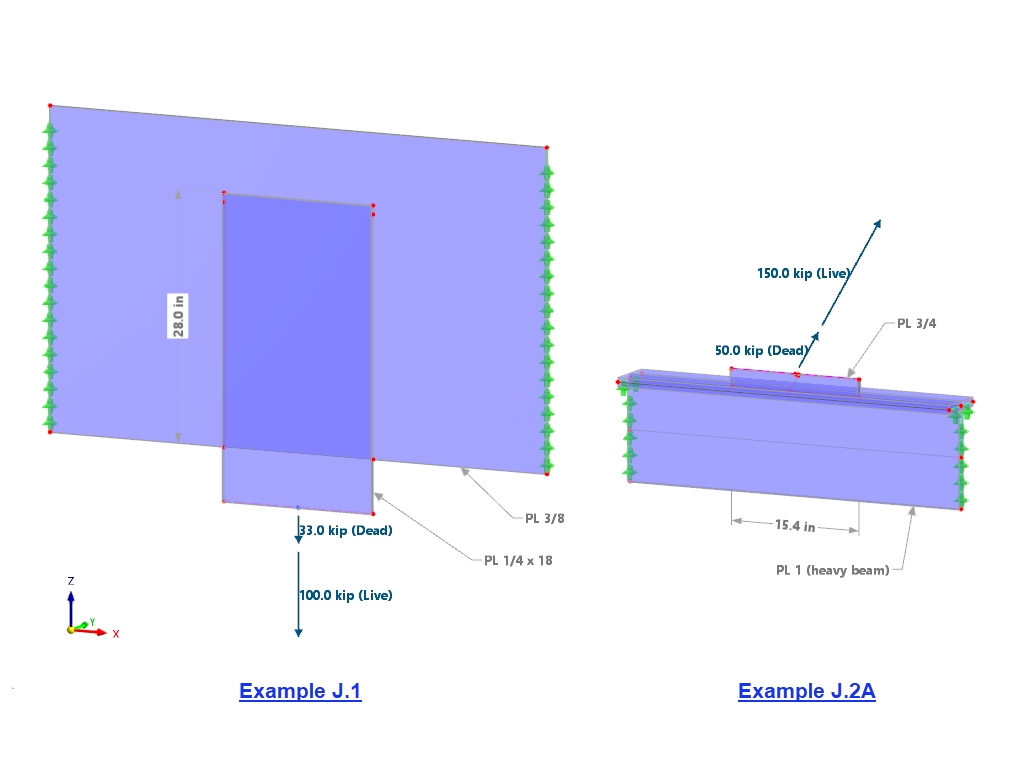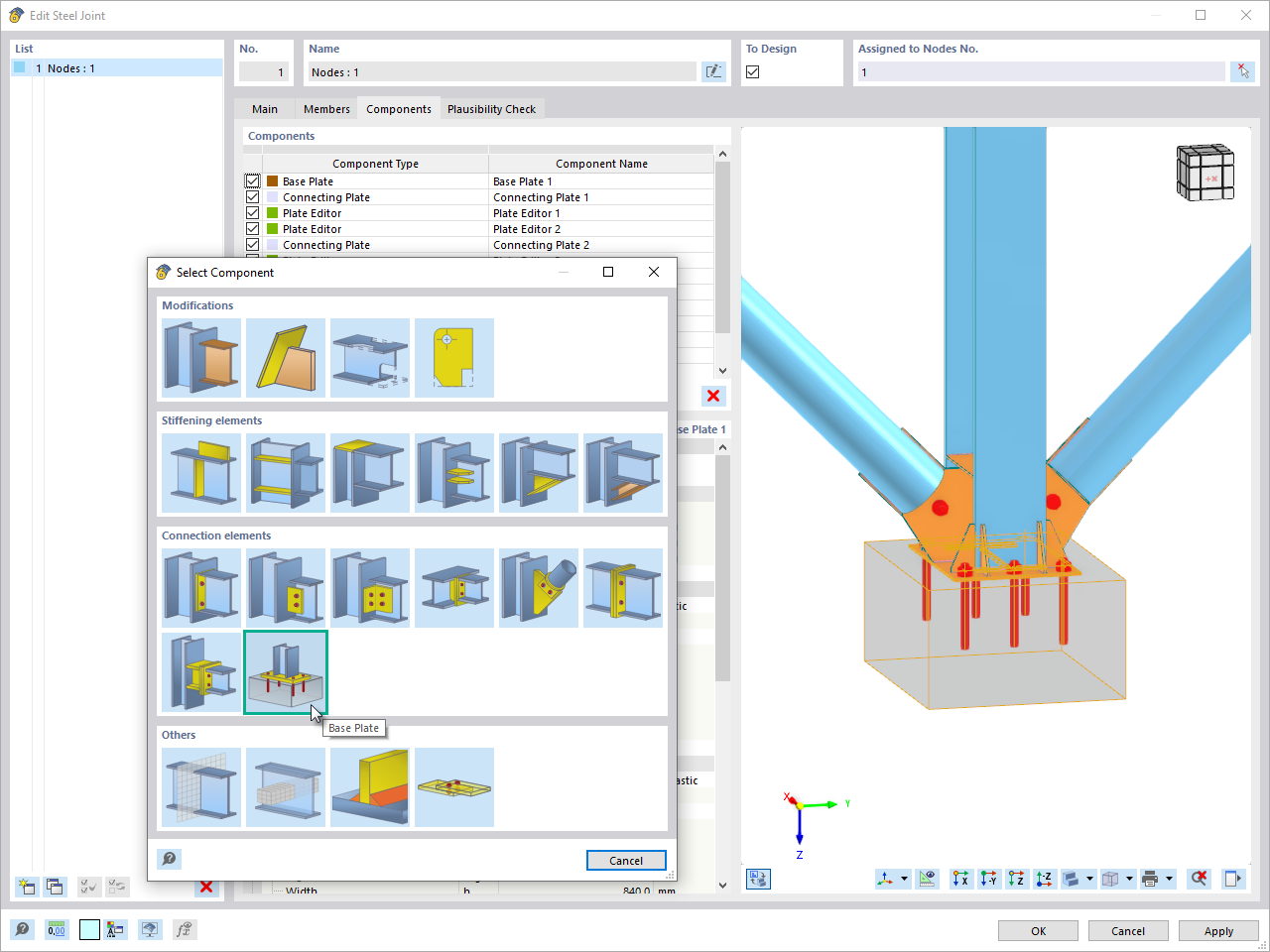System
Cross-Sections:
Principal beams = IPE 550
Secondary beams = HE-B 240
Material:
Structural steel S235 according to DIN EN 1993‑1‑1, Table 3.1
Design Loads
LC 1 Self-Weight:
gd = 1.42 kN/m
LC 2 Imposed Load:
Design Internal Forces
Stability Analysis Without Considering Secondary Beams According to [3] Clause 6.3.2
Under the assumption of a lateral and torsional restraint available at the member's start and end, an ideal critical moment for lateral torsional buckling Mcr of 368 kNm is determined in RF‑STEEL EC3 in line with the verification according to [3], Clause 6.3.2. Thus, the design according to Equation 6.54 results in 1.64. Hence, the ultimate limit state design cannot be fulfilled without the stabilizing effect of the secondary beams.
Stability Analysis Considering Secondary Beams According to [3], Annex BB.2.2
The rules of DIN EN 1993‑1‑1, Annex BB.2.2 assume a continuous rotational restraint over the beam's length. Therefore, the discrete rotational restraint available in the model is "smeared" to a continuous rotational restraint.
Determination of available continuous rotational restraint:
The values are taken from [2] and only adjusted to the notation of Annex BB.2.2.
Cθ,R,k = 11,823 kNm (a component due to the flexural deformation of the secondary beams)
Cθ,D,k = 359 kNm (a component due to the cross-section deformation of the principal beam, the connection to the web is considered)
Conversion to continuous rotational restraint Cθ with average distance of secondary beams:
Determination of the required rotational restraint:
where
Kυ = 0.35 for the elastic cross-section ratio
Kθ = 10 according to DIN EN 1993‑1‑1/NA, Table BB.1
A reduction of Cθ,min by (MEd / Mel,Rd)² is possible:
Verification:
Cθ,prov = 134 kNm/m < Cθ,min = 200.9 kNm/m
The design in the form of the verification of a sufficient restraint for the principal beam's lateral deformation according to Annex BB.2.2 cannot be performed.
Stability Analysis Considering Secondary Beams According to [3], Clause 6.3.4
Determination of the available discrete rotational restraint:
The values are taken from [2] and only adjusted to the notation of Annex BB.2.2.
Cθ,R,k = 11,823 kNm (a component due to the flexural deformation of the secondary beams)
Cθ,D,k = 359 kNm (a component due to the cross-section deformation of the principal beam, the connection to the web is considered)
With this rotational spring, it is possible to describe the structural model of the notionally singled out set of members for the design according to Clause 6.3.4 in Window 1.7 of the add-on module.
During the verification according to 6.3.4, a resolver for eigenvalues implemented in RF‑STEEL EC3 determines the factor αcr,op, by which the smallest ideal critical buckling load can be reached with deformations from the structural system plane.
The critical buckling load factor is shown among the intermediate values (see the result windows) and the corresponding mode shape can be displayed in a separate window. Thus, the result is a moment Mcr of 452.65 kNm ∙ 2.203 = 997.2 kNm.
The design according to Equation 6.63 thus results in 1.01 for the model. For the calculation of αcr,op the load application point was applied in accordance with the detail settings in a destabilizing way on the upper flange. Keeping in mind that the real point of load application is between the upper flange and the shear center, it is possible to ignore the slight exceedance and consider the design to be fulfilled.
Determination of Mcr on FEM Model
With the "Generate Surfaces from Member" function and other available modeling tools, you can easily create a surface model of the structure in a minimum amount of time. It is possible to determine and graphically display the moment My in the beam using the "Result Beam" member type. The critical buckling load factor that is needed can be calculated on the entire model with the RF‑STABILITY add-on module.
With this FEM model, we get a moment Mcr of 447.20 kNm ∙ 2.85 = 1,274.5 kNm. This is a bit higher than the result on the member model with corresponding discrete rotational springs. Consideration could be given to an even more accurate modeling of the connections of the secondary beams.

















.png?mw=350&hash=c6c25b135ffd26af9cd48d77813d2ba5853f936c)
















.png?mw=512&hash=4a84cbc5b1eacf1afb4217e8e43c5cb50ed8d827)

















_1.jpg?mw=350&hash=ab2086621f4e50c8c8fb8f3c211a22bc246e0552)




-querkraft-hertha-hurnaus.jpg?mw=350&hash=3306957537863c7a7dc17160e2ced5806b35a7fb)


.png?mw=600&hash=49b6a289915d28aa461360f7308b092631b1446e)














